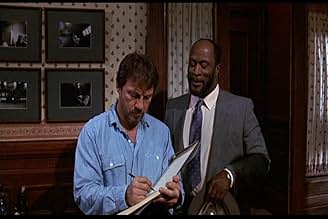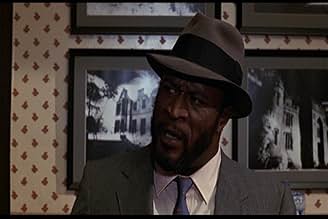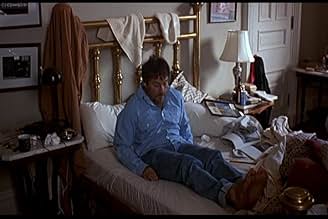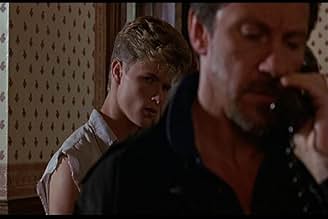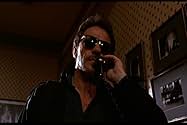VALUTAZIONE IMDb
6,1/10
8763
LA TUA VALUTAZIONE
Una moglie avida uccide il marito, ma non completamente; uno squallido giornalista adotta uno strano gatto nero.Una moglie avida uccide il marito, ma non completamente; uno squallido giornalista adotta uno strano gatto nero.Una moglie avida uccide il marito, ma non completamente; uno squallido giornalista adotta uno strano gatto nero.
- Regia
- Sceneggiatura
- Star
- Premi
- 3 candidature totali
Holter Graham
- Christian (segment "The Black Cat")
- (as Holter Ford Graham)
Recensioni in evidenza
Two mad tales by Edgar Allen Poe as envisioned by two of the most respected horror directors in the world. In The Facts in the Case of Mr. Aldemar we are shown the evils of greed when the wife of a dying man is manipulated through hypnosis to steal his fortune before his death. But when the doorway between our world and the next is inexplicably held open we are introduced to the others. In The Black Cat we are introduced to Usher a crime scene photographer with a dark side and the eye for the macabre. When a proposed photography book falls through he uses his girlfriends cat to add more evil to his already twisted book. But this cat has more than nine lives and an evilness all its' own.A solid outing by two of my all time favorite directors. Barbeau and Keitel steal their respective episodes but look for cameos by Christine Romero and the FX guru Tom Savini. The production design is solid and the make-up effects (by Savini's crew) are awesome. Both tales are briskly paced and fans of the directors' should be pleased. 7/10
Horror meinsters George Romero and Dario Argento each direct an hour long(or so) segment based on stories by Edgar Allan Poe. Romero's is first and is based on a lesser Poe story "The Strange Facts in the Case of M. Valdemar." A wealthy man is dying and hypnotized by a doctor who is aiding the rich man's beautiful wife for money and other fringe benefits. This segment is fairly well-conceived by Romero(who also wrote the script). The horror is more subtle than what you might expect and not very gory. Adrienne Barbeau, still quite a dish, does a good job as the ruthless wife and Ramy Zada does a mediocre job as her accomplice. E. G. Marshall has a bit part that he devours with gusto. The second segment by Argento naturally is the more bizarre and bloody. It is based on the oft-filmed story "The Black Cat." Argento creates a story about a photographer, played by Harvey Keitel, specializing in crime scene photos that also enjoys killing cats. Eventually his instincts lead to much higher organisms. This is also a decent piece as a whole. It has a load of famous actors: John Amos, Martin Balsam, and Kim Hunter. Argento puts a weird dream sequence that is nicely shot but has little relevance to the plot at all. This segment has a big payoff scene at the end that was very original if nothing else. Although certainly more suspenseful then Romero's piece, I liked the first one a bit more. It seemed to have greater continuity. Neither piece has any real life to it, and I think the film suffers a bit from the two story format. It is entertaining though and does provide a few honest chills.
Two Evil Eyes is a collaboration by two horror masters; George A. Romero (Night of the Living Dead), and Dario Argento (Suspiria). Special effects are also provided by the top name in horror movies of the period, Tom Savini. To top it off, both stories are based on works by Edgar Allan Poe, arguably one of the largest influences on works of horror, well... ever. And the efforts of these great names quite lives up to expectations. In fact, it may succeed them if you are aware of the decline in the quality of output by both of these directors around this time period. Romero's next film after Two Evil Eyes was the appalling King adaptation The Dark Half, and Argento's the lukewarm Trauma. So if one is knowledgeable of this it would be nothing but natural to approach this film tentatively. Fortunately, your fears will be calmed. The first half is titled The Facts in the Case of M. Valdemar, and is based on the Poe short story of the same name. Romero's adaptation is a fun and concise update. The storyline is engaging, easy to follow, well acted, well shot. I wouldn't say that it's going to blow your mind but it's certainly enjoyable. Argento's effort, as would be expected, was somewhat more complicated. In terms of quality, plot, and appearance. The Black Cat is, mainly, based on the well known Poe story of the same name. It also incorporates nods to other works by the author and the main character's last name is Usher. The story is somewhat muddled and confusing, but that really comes with the territory when Argento is concerned. There are also a few questionable set choices but overall I really found the second half very enjoyable as well. Overall I really think that Two Evil Eyes is a pretty damn enjoyable selection and probably more even than I've made it sound. It's better than its place in the filmographies of the respective directors would suggest as well.
It's always tricky to evaluate a filmmaker when at work on a film that is in an in-between realm of short and feature. Actually, by technical ruling (or what would be considered by most festivals), it is feature-length with each segment. But I found Two Evil Eyes an underrated effort, after reading many mixed reviews (many leaning to the lesser side for especially Romero's film, and some faint praise for Argento's). The Facts in the Case of Mr. Valdemar and The Black Cat are not the tippy-toppest best for either filmmaker, and for Romero it's a strange kind of quasi-conventional experiment while Argento stays in somewhat familiar territory. Each has its own strengths, own weaknesses, and it's a fine little treat.
'Valdemar': This starts with the veneer of what comes in the range of something like a cross between daytime Soap and a 40s melodrama. A woman (Adrienne Barbeau) married Mr. Valdemar late in life, and as he's about to die (and soon does) she stands to collect a load of money with her cuckold- a smooth operating doctor who has a knack for hypnosis.
What unfolds after his death, and their cover-up in order to secure more funds, is something still like a 'living-dead' movie for the director, but more psychological in head-games and, to be sure, a faithfulness to the Poe source. It is a peculiar feat to adjust to in seeing Romero, at least in the first half hour, directing more like an old pro of the studio era than with his trademark panache in editing and shocks.
This time he brings on the dread in a gradual fashion, built on guilt and paranoia, and then as Valdemar is in that freezer, a Gothic form of psychosis: two people stuck with a body, and a voice, they can't get rid of and become absorbed with. I liked it a lot- maybe more than I should have from what I read (the 'Soap' argument against it I read before, though Romero does try to give his actors more to work with than any hack would)- as it preys on the fear of death as not a final measure, with one last wicked kick in the nuts with that bed scene. Top shelf Romero? Not quite, but it's still oddly gripping, like a polished piece of clichés giving way to a wild head game of "old-school" horror.
8/10 'Black Cat': Argento's dip in the Poe pool goes to the lengths that he as a director always goes to: elaborate-to-the-Italian-horror degree style in camera and deranged horror, and even bits of dark horror that almost make Poe seem tame. I can't say how much this is tied into Poe more than I can Valdemar, but try as I might I couldn't see this as being totally peak Argento either, despite (or almost in spite of) everything he has going for it. Like Valdemar, it's about someone not coping with life after death; a photographer (Keitel) into the macabre, with a (color me shocked Argento) violinist girlfriend, has a black cat, whom the photographer strangles while taking some provocative photos. She knows he's behind it, but he can't stop himself- he needs another cat- just like the old cat- which will meet some grisly consequences.
Keitel's always game for something like this part, which plays like his Bad Lieutenant gone Grand Guignol, which makes for one of the best pleasures of the project. He doesn't have a whole lot of range in the role, but it's a fun one for him, chewing on the meat that Argento throws out for him scene after scene. Argento, meanwhile, even for *him* overdoes it with the horror music in certain scenes, and dares to go to too much excess with the symbolism of the white spots on the cat. But it's totally a wonder to see that dream sequence, where Keitel is in the midst of a medieval Pagan sacrifice, with a sharp cut-away in the most violent bit.
And I loved the pleasure that Argento takes in enlivening Poe's macabre with his own, with the violence extending from mania into the visual. I had my complaints at times, but it's hard to not throw up one's hands with Argento and say "why carp!" when he's unabashed in his passions of mostly constant camera movement (tracking, cranes, close-ups, pans, you-name-it) and illogical steps in plot (i.e. why Keitel's character would even put out a book with cat deaths knowing his girlfriend might see them, let alone so soon).
8/10 Bottom line, fans of the directors should check out the films, and decide for themselves how they do. It's two tall tales of curses and death, derangement and the surreal, and it's a concoction worth at least one viewing.
'Valdemar': This starts with the veneer of what comes in the range of something like a cross between daytime Soap and a 40s melodrama. A woman (Adrienne Barbeau) married Mr. Valdemar late in life, and as he's about to die (and soon does) she stands to collect a load of money with her cuckold- a smooth operating doctor who has a knack for hypnosis.
What unfolds after his death, and their cover-up in order to secure more funds, is something still like a 'living-dead' movie for the director, but more psychological in head-games and, to be sure, a faithfulness to the Poe source. It is a peculiar feat to adjust to in seeing Romero, at least in the first half hour, directing more like an old pro of the studio era than with his trademark panache in editing and shocks.
This time he brings on the dread in a gradual fashion, built on guilt and paranoia, and then as Valdemar is in that freezer, a Gothic form of psychosis: two people stuck with a body, and a voice, they can't get rid of and become absorbed with. I liked it a lot- maybe more than I should have from what I read (the 'Soap' argument against it I read before, though Romero does try to give his actors more to work with than any hack would)- as it preys on the fear of death as not a final measure, with one last wicked kick in the nuts with that bed scene. Top shelf Romero? Not quite, but it's still oddly gripping, like a polished piece of clichés giving way to a wild head game of "old-school" horror.
8/10 'Black Cat': Argento's dip in the Poe pool goes to the lengths that he as a director always goes to: elaborate-to-the-Italian-horror degree style in camera and deranged horror, and even bits of dark horror that almost make Poe seem tame. I can't say how much this is tied into Poe more than I can Valdemar, but try as I might I couldn't see this as being totally peak Argento either, despite (or almost in spite of) everything he has going for it. Like Valdemar, it's about someone not coping with life after death; a photographer (Keitel) into the macabre, with a (color me shocked Argento) violinist girlfriend, has a black cat, whom the photographer strangles while taking some provocative photos. She knows he's behind it, but he can't stop himself- he needs another cat- just like the old cat- which will meet some grisly consequences.
Keitel's always game for something like this part, which plays like his Bad Lieutenant gone Grand Guignol, which makes for one of the best pleasures of the project. He doesn't have a whole lot of range in the role, but it's a fun one for him, chewing on the meat that Argento throws out for him scene after scene. Argento, meanwhile, even for *him* overdoes it with the horror music in certain scenes, and dares to go to too much excess with the symbolism of the white spots on the cat. But it's totally a wonder to see that dream sequence, where Keitel is in the midst of a medieval Pagan sacrifice, with a sharp cut-away in the most violent bit.
And I loved the pleasure that Argento takes in enlivening Poe's macabre with his own, with the violence extending from mania into the visual. I had my complaints at times, but it's hard to not throw up one's hands with Argento and say "why carp!" when he's unabashed in his passions of mostly constant camera movement (tracking, cranes, close-ups, pans, you-name-it) and illogical steps in plot (i.e. why Keitel's character would even put out a book with cat deaths knowing his girlfriend might see them, let alone so soon).
8/10 Bottom line, fans of the directors should check out the films, and decide for themselves how they do. It's two tall tales of curses and death, derangement and the surreal, and it's a concoction worth at least one viewing.
George Romero and Dario Argento, two great horror directors, tackling two short stories by Edgar Allan Poe. Sounds like a surefire hit. So why isn't it? Romero writes and directs his story, "The Facts in the Case of Mr. Valdemar." It's about a woman (Adrienne Barbeau) whose rich husband, Ernest Valdemar, is on his deathbed. A doctor (Ramy Zada) she's been having an affair with hypnotizes Valdemar into signing over all of his money to his wife. But Valdemar dies while hypnotized so he's stuck in between life & death and is surprisingly unhappy about it.
The biggest problem with Romero's story is that it feels like it was made for television. The annoyingly cheap and ceaseless music score doesn't help. Barbeau is the best part. She makes a paper-thin character work. She's also some very nice eye candy. E.G. Marshall plays Valdemar's attorney, who knows something is up but can't do much about it. Tom Atkins plays a homicide detective who conveniently answers 911 calls about screaming neighbors. The climax sees Romero turning Poe's story into something that belonged in Creepshow, which Romero directed and Barbeau, Atkins, and Marshall also appeared in. If this story was the entire movie, I might rate it a little higher. It's not great and there are big problems (that music!) but it's a passable time-killer. However, the other story drags the score down.
The Argento story is more stylishly directed, as you might expect. It's also more poorly written, as you might also expect. It's got lots of Poe references to establish Argento is clearly a fan but there's nothing of Poe's talent in this one. The story is "The Black Cat" and it's about a crime scene photographer (Harvey Keitel) who kills his girlfriend's cat. Then he goes crazy and it's a whole thing. Honestly, even with Keitel's bizarre performance and Argento's visuals, this one was a snoozer for me.
I think if you look at some of the other reviews here, particularly from those who love the movie, you'll see I'm in the minority on this. Most people seem to prefer Argento's story and hate Romero's. In a way, I get that. Argento has more style and a devoted cult following. I have enjoyed several of his horror films, though not enough to call myself a big fan of his. So take that into consideration. If you're someone who generally prefers a Dario Argento type of horror film, you are likely to prefer the second story to the first. Either way I'll be surprised if you love either of them, as they are both pretty mediocre.
The biggest problem with Romero's story is that it feels like it was made for television. The annoyingly cheap and ceaseless music score doesn't help. Barbeau is the best part. She makes a paper-thin character work. She's also some very nice eye candy. E.G. Marshall plays Valdemar's attorney, who knows something is up but can't do much about it. Tom Atkins plays a homicide detective who conveniently answers 911 calls about screaming neighbors. The climax sees Romero turning Poe's story into something that belonged in Creepshow, which Romero directed and Barbeau, Atkins, and Marshall also appeared in. If this story was the entire movie, I might rate it a little higher. It's not great and there are big problems (that music!) but it's a passable time-killer. However, the other story drags the score down.
The Argento story is more stylishly directed, as you might expect. It's also more poorly written, as you might also expect. It's got lots of Poe references to establish Argento is clearly a fan but there's nothing of Poe's talent in this one. The story is "The Black Cat" and it's about a crime scene photographer (Harvey Keitel) who kills his girlfriend's cat. Then he goes crazy and it's a whole thing. Honestly, even with Keitel's bizarre performance and Argento's visuals, this one was a snoozer for me.
I think if you look at some of the other reviews here, particularly from those who love the movie, you'll see I'm in the minority on this. Most people seem to prefer Argento's story and hate Romero's. In a way, I get that. Argento has more style and a devoted cult following. I have enjoyed several of his horror films, though not enough to call myself a big fan of his. So take that into consideration. If you're someone who generally prefers a Dario Argento type of horror film, you are likely to prefer the second story to the first. Either way I'll be surprised if you love either of them, as they are both pretty mediocre.
Lo sapevi?
- QuizDario Argento originally wanted the film to be a collaboration between four directors: him, George A. Romero, John Carpenter, and Wes Craven. Carpenter and Craven pulled out, so Argento and Romero decided to tackle the project as a two-part story, each directing his own segment separately.
- BlooperIn second story when police comes to search the house, phone is shown unplugged and not working, but it rings just a few minutes later, working fine.
- Citazioni
Roderick Usher (segment "The Black Cat"): Hey, this is my fucking kitchen , and I'll fucking stay, and I'll fucking drink if I fucking want!
[phone rings]
Roderick Usher (segment "The Black Cat"): I DIDN'T FUCKING DO ANYTHING!
- Curiosità sui creditiBefore the narrative of the film starts, the Poe house in Baltimore is shown, with a plaque reading: Edgar Allan Poe 1809 1849 Dreaming dreams no mortal ever dared to dream before.
- ConnessioniFeatured in Dario Argento: Master of Horror (1991)
I più visti
Accedi per valutare e creare un elenco di titoli salvati per ottenere consigli personalizzati
- How long is Two Evil Eyes?Powered by Alexa
Dettagli
- Data di uscita
- Paesi di origine
- Lingua
- Celebre anche come
- Dos ojos diabólicos
- Luoghi delle riprese
- 1250 Fox Chapel Road, Fox Chapel, Pittsburgh, Pennsylvania, Stati Uniti(Valdemar mansion - segment "The Facts in the Case of Mr. Valdemar")
- Aziende produttrici
- Vedi altri crediti dell’azienda su IMDbPro
Botteghino
- Budget
- 9.000.000 USD (previsto)
- Lordo Stati Uniti e Canada
- 349.618 USD
- Fine settimana di apertura Stati Uniti e Canada
- 260.410 USD
- 27 ott 1991
- Lordo in tutto il mondo
- 349.618 USD
- Tempo di esecuzione2 ore
- Colore
- Mix di suoni
- Proporzioni
- 1.85 : 1
Contribuisci a questa pagina
Suggerisci una modifica o aggiungi i contenuti mancanti


